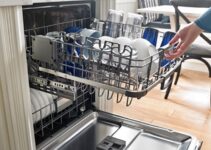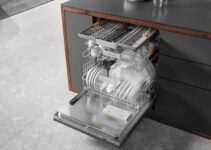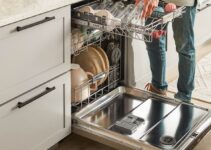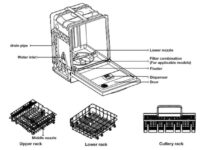If your Hotpoint dishwasher fails to start, there are several things you can do on your own before calling a professional. These fixes are easy to follow, however, if none of the common fixes can get your dishwasher working again, you should consider getting a professional to take a look at it.
Hotpoint Dishwasher Not Starting: Likely Causes & DIY Fixes
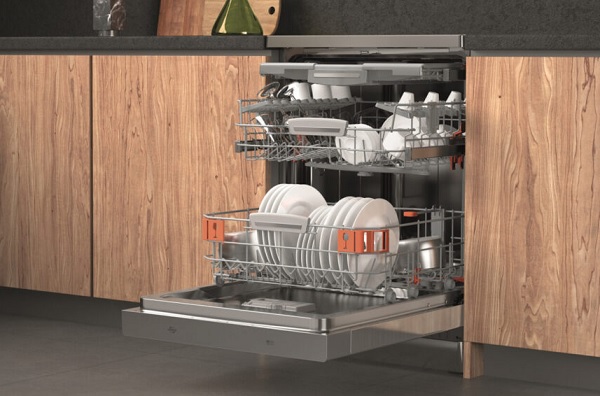
1. Blown Thermal Fuse
The thermal fuse in the Hotpoint dishwasher is a safety feature designed to protect the appliance from serious damage due to overheating.
The fuse is designed to shut off power to the dishwasher when the appliance gets too hot. This will protect the dishwasher from being damaged by overheating. If the fuse is blown due to overheating, there will be no power to the dishwasher and it will not turn on.
How to Fix
To check if the fuse is blown, you will need to inspect it. You might be able to tell a blown fuse through its burnt odor but this is not always the case. Using a multimeter to test for continuity helps you to better access the situation.
If the fuse has a continuous electrical path which proves it is still functional, you will be able to notice signs of continuity using the multimeter. If not, there will be no continuity and the fuse would have to be replaced.
Make sure you unplug the dishwasher before looking for the thermal fuse.
Open the access door panel and locate the thermal fuse which should be at the top of the circuit board. You will find two wires attached to it.
Check for continuity with a multimeter. If the fuse is still functional, it should read zero ohms on the multimeter. If it doesn’t, it should be replaced.
A blown fuse could signal more problems for the dishwasher. This could mean that the dishwasher is overheating so you need to check other components for damage. You might want to get a technician to take a look at the dishwasher to identify the origin of your overheating issues to prevent more expensive fixes in the future.
2. Faulty Door Latch
The door latch assembly is designed to hold the door closed during a wash cycle to prevent water from leaking. Within the door latch is the door latch switch that provides power to the dishwasher controls.
If the dishwasher door isn’t closed properly or the door does not latch securely when it is closed, the dishwasher won’t receive power to complete a wash cycle which could be the reason why your dishwasher is not running.
How to Fix
You will have to inspect the door latch for faults. If you notice that the door latch is broken, then you would have to replace it.
3. Defective Door Switch
The door switch in the door latch is a protective feature that prevents the dishwasher from running while the door is open. If the door switch is defective, the switch will allow the dishwasher to run even if the door latch is closed properly.
How to Fix
To determine if the door switch is faulty, inspect the switches at the top of the dishwasher door and check that both switches are mechanically activated when the door closes. You will have to use a multimeter to check for continuity. If there is no continuity, then you should replace the switch. Ensure that the dishwasher is turned off when making these checks.
4. Defective Selector Switch
The selector switch allows you to choose different washing, drying, and heating options for a wash cycle. If the selector switch fails or is not depressed correctly, it could cause the dishwasher to not run.
This problem could be caused by mishandling the dishwasher. Ensure that you read through the user manual before operating the machine.
How to Fix
To check if the selector switch is defective, locate the switch on the control panel and check if it is stuck between settings. Also, check to see if more than one button has been pressed at the same time.
If you press more than one button at the same time, this could create a no-continuity situation for your selector switch and cut off power to these controls.
5. Defective motor start relay
A defective motor relay could be the cause of your dishwasher not turning on. You can confirm this by checking if the appliance is actually receiving power but not turning on. However, this doesn’t always mean that the motor relay is defective. Inspecting the component should give you the confirmation to replace it.
How to Fix
Locate the part next to the motor and check the motor relay for defects. You will need to use a multimeter to check for continuity. The motor relay features a coil portion and a switch contact portion.
You will have to test the coil portion for continuity. The coil portion of the relay will show continuity at all times while the switch contact portion will only show continuity when activated. If there is no continuity in the coil portion then you would have to replace the motor relay.
6. Failed Drive Motor
The dishwasher drive motor circulates water during a wash cycle which cleans your dishes and other items during a cycle. A dishwasher not starting issue could indicate a problem with the motor.
If the dishwasher won’t start and you have confirmed that the start relay is effective and sends power to the motor, your drive motor could be faulty.
How to Fix
A failing motor would have to be checked by a technician. However, If you’ve noticed a loud noise or loud humming sounds coming from the motor during previous wash cycles, it could be due to the failing motor. You should replace your motor to get the dishwasher functioning properly.
7. Faulty Timer
The timer determines the power flow to the parts of the dishwasher and the appropriate time for such flow of power. If the timer is defective, it might not send power to the dishwasher and the appliance will not start.
How to Fix
The timer should be the last thing you check on the dishwasher. After checking other areas, you can inspect the timer for faults and replace it if needed.


